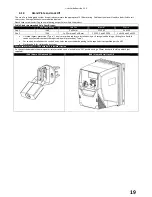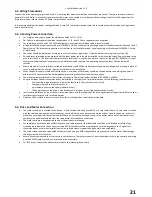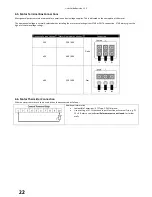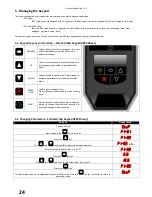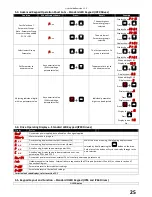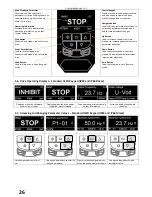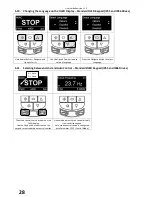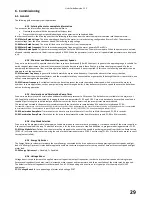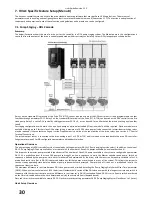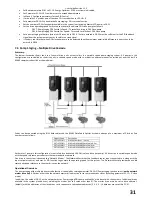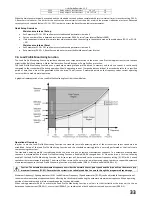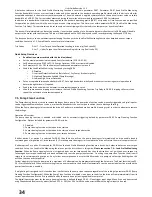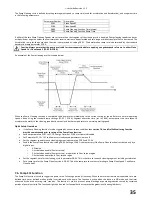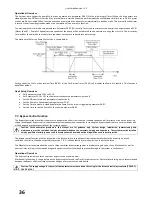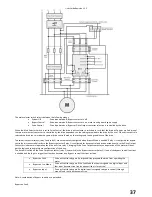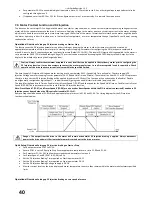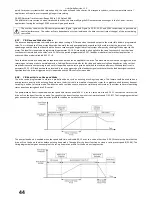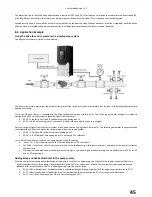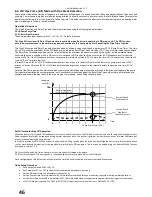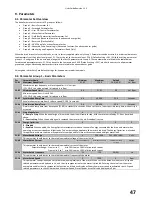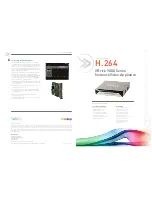
User Guide Revision 1.12
32
When the system is enabled the master drive will check the run time clocks for all drives in the network which are stored and maintained
within menu 0 of the master drive. The first available drive with the lowest run time is automatically run first. At a predefined level additional
drives / pumps are brought on-line in sequence to assist the running pumps. Switch on sequence is always defined by the pump run time
clocks of the available drives (monitored and maintained by the master drive) with the least run time pump switched in first. A pre-defined
settle time (Set in P8-19) is observed before any further pumps are switched in or out of the system. This allows the system to reach a steady
operating state before additional pump requirements are assessed. Pump switch off is done at a predefined level in the sequence of least run
time.
Maximum and minimum speed and Ramp times for each drive in the network are determined by the individual setting on each drive (P1-01 to
P1-04).
The maximum difference in run time between drives / pumps can be limited by setting the ‘Pump Staging Duty Switch Over Time’ parameter
(P8-16). When a value is entered into P8-16 the network master drive will automatically switch off the drive / pump with the longest run time
and switch in the drive / pump with the shortest run time once the difference in run times set in P8-16 is exceeded. When P8-16 is set to 0
pump switch-over based on run time is disabled and switch over is determined only by the threshold limits (demand based).
Duty run time clocks are available to view in P0-19 of the network master drive. Clocks are reset by setting parameter P8-20 ‘Pump Staging
Master Clock Reset’ to 1 (reset) on the network master drive.
The Network Master will assume that any drive not responding to network messaging is currently unavailable (powered off / RS485
disconnected). The Network master will continue to poll drives that are offline but will not attempt to run the drive until communication is re-
established.
When any drive, including the network master, enters into a trip condition it will be temporarily suspended from operation and the system will
maintain operation with the remaining available drives. When a drive is reset from a trip condition it will automatically become available for
selection by the network master.
The enable input (T1 – T2) to the network master is deemed to be the enable for the complete system and causes system operation to start or
stop. Individual enable inputs (T1 – T2) on the network slave drives provide an inhibit input that prevent operation of that particular drive.
Quick Setup Overview:
On all HVAC Drives
Set Basic parameters P1-01 to P1-10 on all drives in the system. Energy Optimiser P1-06 must remain disabled.
Set Parameter P1-14= 101 to allow access to extended parameters
On the Network Master
In Menu 3, Configure parameters for the PID Control
Ensure the network serial address in P5-01 is left as default (1)
Set parameter P8-14=2 to enable the Pump staging – Multiple Drive Cascade function
Set the number of network slave pumps available in the system (not including Network Master VFD) in P8-15
Set the drive operating speed limits used to activate / deactivate network slave pumps as follows:
o
P8-17: Pump Staging Assist Switch In Speed – Threshold to bring in assist pump
o
P8-18: Pump Staging Assist Switch Out Speed – Threshold to switch out assist pump
Set a pump staging settle time (minimum 10 seconds) in P8-19. The time entered in P8-19 must be sufficient for the PID feedback
signal from the system output sensor to settle to a steady level.
If the duty run times between all available drives / pumps are to be balanced then the maximum permissible difference in hours
should be entered in P8-16.
On the Network Slaves
Set the drives to network slaves by setting P1-12 = 5
Set the network serial address in P5-01 to unique addresses is sequence, starting at address 2 (2, 3, 4, 5...)
7.3.
Maintenance Interval Set-up and Reset
The drive has a maintenance interval timer function with visible display indication and configurable output points to allow the programmer to
set-up routine maintenance schedules / intervals for the machine / system and to indicate maintenance due to the machine operator. The
maintenance interval is calculated from the ‘Drive hours run clock’ and is hence an indication of the operational use of the drive system rather
than a basic calendar based timer function.
Operational Overview:
The maintenance interval is enabled and configured by parameter P6-24, Service Interval Timer. When P6-24 is set to 0 the maintenance
interval timer is disabled. The maintenance interval (P6-24) is set in hours between 1 and 60000 (default 5000 hours). Access to parameter
menu 6 is permitted only when the advanced security level password is entered into P1-14 (default password 201). The maintenance interval
timer is initiated when a valid value is entered into P6-24. The time remaining until maintenance becomes due is stored and displayed in
parameter P0-22 (Time Left to Next service).
When the maintenance interval expires (P0-22 reaches 0) the drive can indicate maintenance due on the machine in the following ways:
The maintenance symbol is automatically displayed on the OLED display
(alternating with drive communications address in top right corner.
One of the drive relay outputs can be configured for indication of
maintenance due,
A warning bit in the drive communications status words is set (see
associated communications guide).
The following parameters are used to configure the relay drive outputs to represent Service Due.
Parameter Number
Parameter Description
Terminal
Value set
Содержание HVAC H2
Страница 1: ......
Страница 72: ...User Guide Revision 1 12 72 82 H2MAN BE_V1 11...


